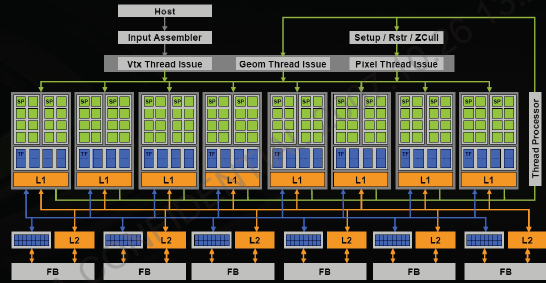The GeForce 8800 GT is no slouch
NVIDIA - AMD's big rival in graphics - has been busy of late, too, brushing up its mid-range DX10 line-up a week or two before AMD's new GPUs. It's also moved towards a recently-announced SKU that's based on excellent G80 technology and promises an excellent price-to-performance ratio. So, let's formally introduce the GeForce 8800 GT 512!
But what constitutes a GeForce 8800 GT?
Think of it as the bastard child from a tryst between G80 (GeForce 8800) and G84 (GeForce 8600). However, it follows in daddy's (G80's) footsteps rather more than chained-to-the-kitchen mummy. Let us explain.


The two simplified architectural diagrams above represent the innards of the all-singing, all-dancing GeForce 8800 Ultra (top) and GeForce 8800 GT. A brief look makes clear the commonality between the two SKUs. Indeed, GeForce 8800 GT is a direct derivation of the Ultra, in so far as the diagrams are concerned. However, the newest 8-series GPU does pack in a few extras and we'll come to those in a moment.
GeForce 8800 GT packs in seven blocks of 16 scalar stream processors, for a total count of 112 - down from the 128 on the GTX and Ultra but up from the 96 on the GTS variants.
Each block has access to its own texture-filtering units, together with their associated L1 cache. Totting up the numbers, each of the GeForce 8800 GT's seven blocks can address eight pixels per clock, just like the G84s, and also has eight efficient texture-filtering units. In raw numbers that mean that the GeForce 8800 GT can output 28 pixels per clock with 2x anisotropic filtering (FP16 textures).
GeForce 8800 GT 16 ROPs are a larger trade-off than present GeForce 8800 GTS (96 SPs/20 ROPs) and the GPU may struggle a touch with exorbitant antialiasing and ultra-high resolutions. Further compounding this matter is the comparative lack of memory bandwidth via four 64-bit (256-bit) connections to the local frame buffer.
What you don't see
Clocks speeds
GeForce 8800 GT ships with a reference speeds of 600MHz (core), 1500MHz (shader) and 1800MHz (memory). Given what we already know about the basic SP/TF/ROP setup, it'll have significant shading power (336GFLOP/s) and an impressive fill-rate (16GTexels/s) for what is, essentially, a mid-range part. Initial SKUs will feature 512MiB of onboard memory and NVIDIA's partners will introduce 256MiB SKUs in around a month, we reckon.
65nm manufacturing process, GPU refinements and a single-slot design
Present 8800-series GPUs are made on a 90nm process node. GeForce 8800 GT is based on a smaller, more-efficient 65nm node, allowing NVIDIA to ship the highly-clocked part (105W TDP) with a single-slot cooler. The transistor count of 754M is higher than G80's, primarily due to NVIDIA amalgamating the input/output logic onto the GPU itself.
Borrowing from the G84 series of cards, the 8800 GT carries the VP2 video-processing engine that offloads from the CPU much of the computational load arising from the decoding of high-definition H.264 and VC-1 content. We note that NVIDIA covers the entire H.264 pipeline but doesn't hardware-accelerate the first computationally-expensive entropy stage for VC-1-encoded titles.
Given the 2D similarities to GeForce 8600 GTS, the new GPU will include two dual-link-capable DVI ports with GPU-based HDCP compatibility - no external keys or ASIC required here.
Pricing
GeForce 8800 GT promises to be a GTS 320-beating part that ships with a single-slot cooler and adds some expected 2D features. The killer feature, though, is the price. Default-clocked models will ship from around £165, rendering the present GeForce 8600 GTS and GeForce 8800 GTS 320 practically redundant. The pricing is such that it's in the same ballpark, albeit a little dearer, than Radeon HD 3870, so a head-to-head comparison is valid.
NVIDIA and AMD have gone about designing power-saving mid-range cards in two reasonably similar ways. Each has its strengths and weaknesses, so head on over to the following page as we dissect their vital stats before journeying into some furious benchmarking analysis.









